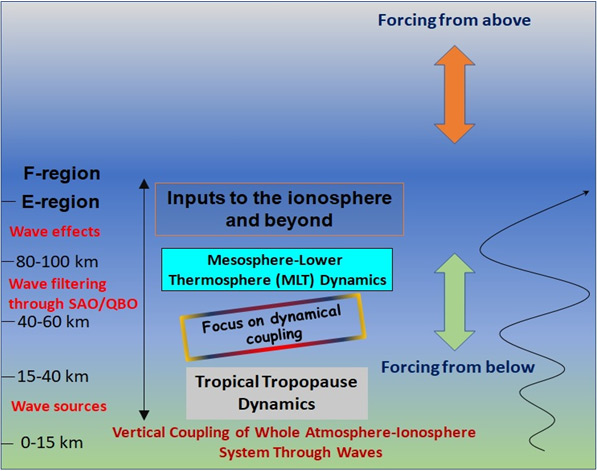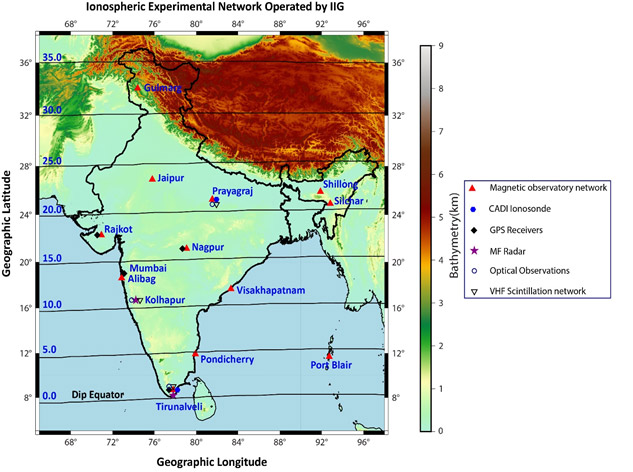Dynamical and Electrodynamical Coupling of the Atmosphere-ionosphere system using radio and optical techniques (DECA)
Chief Coordinator : S. Sripathi & Members
Project Description:
The unique geometry of the Earth’s geomagnetic fields at the equatorial and low latitudes is responsible for the large scale development of Equatorial Electrojet (EEJ) or Counter Electrojet (CEJ), Equatorial Ionization Anomaly (EIA) and Equatorial Spread-F (ESF) irregularities. While significant progress has been made in the past few decades in understanding their seasonal and long-term variabilities, there are gaps in our understanding especially at shorter-scales such as day to day variability that requires further investigations.
At the low latitudes, differential heating of the Earth’s surface due to insolation, convection, orography, etc. generate atmospheric waves (e.g., tides, gravity waves, planetary waves) over a broad spectrum. Some of the upward propagating waves either get absorbed or dissipate in the mesosphere-lower thermosphere (MLT) region and excite higher-order waves. A portion of these primary and higher-order waves penetrate to the thermosphere-ionosphere region and perturb the background neutral and plasma parameters there. On the other hand, phenomena such as semi-annual oscillations (SAO), Quasi-Biennial Oscillations (QBO), and sudden stratospheric warming (SSW) modulate the background atmosphere and control the energy and momentum of the upward propagating of the atmospheric waves. In addition, lightning can also trigger gravity waves and electromagnetic impulses that often propagate to the MLT region and produce sprites and Gigantic Jets.
Apart from the forcing from below, the solar wind-magnetosphere-ionosphere coupling at high latitudes can also perturb the equatorial ionosphere-thermosphere system during space weather events. They can cause positive/negative ionospheric storms, impact the ESF onset, and affect radio communication significantly. Also, previous studies have shown that space weather disturbances can reduce the usable spectrum and coverage of skywave signals by more than 50 %. Skywave communications become vital during natural disasters when terrestrial communication networks are disrupted. Hence, we need to understand both forcing from above and below to comprehend the complex dynamics and electrodynamics of the low-latitude and equatorial ionosphere to achieve prediction capabilities.

The new science program, DECA has been carefully crafted to address the whole atmosphere-ionosphere coupling processes under severe terrestrial and space weather events. IIG has a strong ground-based observational network of radio and optical instruments deployed at several sites across India. The objective of this project is to understand the variabilities in the middle and upper atmospheric structure and dynamics using airglow, ionosondes, ground radars, VLF receivers, ICM and GPS receivers. Under the DECA program, it is envisaged to utilize neural networks and machine learning algorithms for data mining, advanced models as well as data assimilation techniques to advance our data-based science using the existing observational datasets. We also plan to develop algorithms to extract ionospheric parameters using ionosonde observation to obtain near real-time information on the state of the ionosphere. The proposed studies have potential applications for navigation and radio wave propagation methods. The investigations using the radio wave probing techniques also enhance understanding of the scale-size dependent characteristics of ionospheric plasma irregularities and ionospheric scintillations, their evolution, and solar flux dependency.

VHF Radar at magnetic equator: It is proposed to setup new coherent VHF radar at Tirunelveli to investigate the ionospheric plasma irregularities and plasma drifts in the equatorial E and F regions of the ionosphere. This radar is very useful tool to investigate the equatorial electric fields and seeding of the equatorial plasma bubbles (EPBs). The importance of this radar is that not many such coherent radars available over the magnetic equator across the longitudes to investigate the ionospheric fields and plasma drifts.
Significance of this Research
The forcing from the below and above will have significant impact on the radio wave communications and GPS navigation. Since we depend on satellite communication for many of our day to day activity, the space weather and its impacts on the GPS navigation and radio wave communication has significant role to play. The operational forecasting of GPS range errors, probability of EPB/scintillation occurrence are believed to be impacted by the forcing from the above and below. Hence, the studies conducted under this program/project will have implications for navigation and radio wave propagation applications.
Chief Coordinator : S. Sripathi
Coordinator(s) : S. Tulasiram
Members : S. Sripathi (SS), S. Gurubaran (SG), S. Tulasiram (ST), Rajesh Singh (RS), R. Ghodpage (RG), Navin Parihar (NP), S. Sathish Kumar (SK), Jayashree (JB), Shantanu Pandey (SP), Sukanta Sau (Sau), Students/RAs associated with this program
Technical Team : PT Patil, Selvaraj, N Venkatesh, Prabhakar Tiwari, Sarvesh Chandra
{updated on 05-08-2024}